grc-dor, Ἀπέλλων, Apéllōn, ; grc, Ἀπείλων, Apeílōn, label=
la, Apollō, la, Apollinis, label=genitive, , ; , is one of the
Etymology
Apollo (Greco-Roman epithets
Apollo's chiefSun
*Aegletes ( ; Αἰγλήτης, ''Aiglētēs''), from , "light of the sun" *Helius ( ; , ''Wolf
*Lycegenes ( ; , ''Lukēgenēs''), literally "born of a wolf" or "born of Lycia" *Lycoctonus ( ; , ''Lykoktonos''), from , "wolf", and , "to kill"Origin and birth
Apollo's birthplace wasPlace of worship
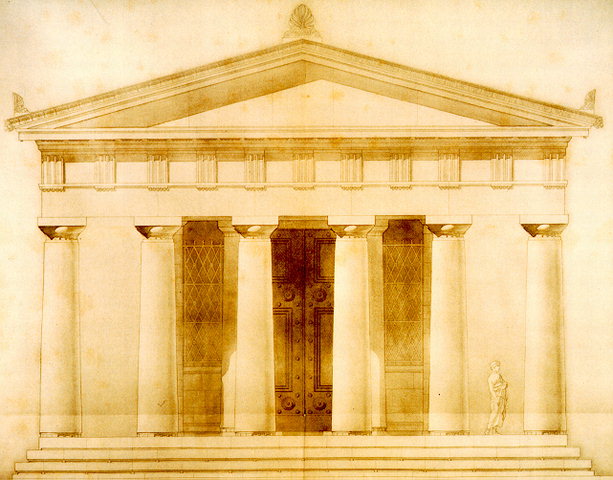

Healing and disease
*Acesius ( ; , ''Akesios''), from , "healing". Acesius was the epithet of Apollo worshipped inFounder and protector
*Prophecy and truth
*Coelispex (Roman) ( ), from Latin ''coelum'', "sky", and ''specere'' "to look at" *Iatromantis ( ; , ''Iātromantis'',) from , "physician", and , "prophet", referring to his role as a god both of healing and of prophecy *Leschenorius ( ; , ''Leskhēnorios''), from , "converser" *Loxias ( ; , ''Loxias''), from , "to say", historically associated with , "ambiguous" *Manticus ( ; , ''Mantikos''), literally "prophetic" *Proopsios (), meaning "foreseer" or "first seen"Music and arts
*Musagetes ( ;Archery
*Aphetor ( ; , ''Aphētōr''), from , "to let loose" *Aphetorus ( ; , ''Aphētoros''), as the preceding *Arcitenens (Roman) ( ), literally "bow-carrying" *Argyrotoxus ( ; , ''Argyrotoxos''), literally "with silver bow" *Clytotoxus ( ; , ''Klytótoxos''), "he who is famous for his bow", the renowned archer. *Hecaërgus ( ; , ''Hekaergos''), literally "far-shooting" *Hecebolus ( ; , ''Hekēbolos''), "far-shooting" *Ismenius ( ; , ''Ismēnios''), literally "of Ismenus", after Ismenus, the son ofAppearance
* Acersecomes (, ''Akersekómēs''), "he who has unshorn hair", the eternal ephebe. * Chrysocomes ( ; , ''Khrusokómēs''), literally "he who has golden hair."Amazons
* Amazonius (),Other
*Patroos (Πατρώος, ancestral), there is theCeltic epithets and cult titles
Apollo was worshipped throughout theOrigins
 The cult centers of Apollo in Greece,
The cult centers of Apollo in Greece, Healer and god-protector from evil
 In classical times, his major function in popular religion was to keep away evil, and he was therefore called "apotropaios" (, "averting evil") and "alexikakos" ( "keeping off ill"; from v. + n. ). Apollo also had many epithets relating to his function as a healer. Some commonly-used examples are "paion" ( literally "healer" or "helper") "epikourios" (, "succouring"), "oulios" (, "healer, baleful") and "loimios" (, "of the plague"). In later writers, the word, "paion", usually spelled "Paean", becomes a mere epithet of Apollo in his capacity as a god of
In classical times, his major function in popular religion was to keep away evil, and he was therefore called "apotropaios" (, "averting evil") and "alexikakos" ( "keeping off ill"; from v. + n. ). Apollo also had many epithets relating to his function as a healer. Some commonly-used examples are "paion" ( literally "healer" or "helper") "epikourios" (, "succouring"), "oulios" (, "healer, baleful") and "loimios" (, "of the plague"). In later writers, the word, "paion", usually spelled "Paean", becomes a mere epithet of Apollo in his capacity as a god of Dorian origin
The '' Homeric Hymn to Apollo'' depicts Apollo as an intruder from the north. The connection with the northern-dwellingMinoan origin
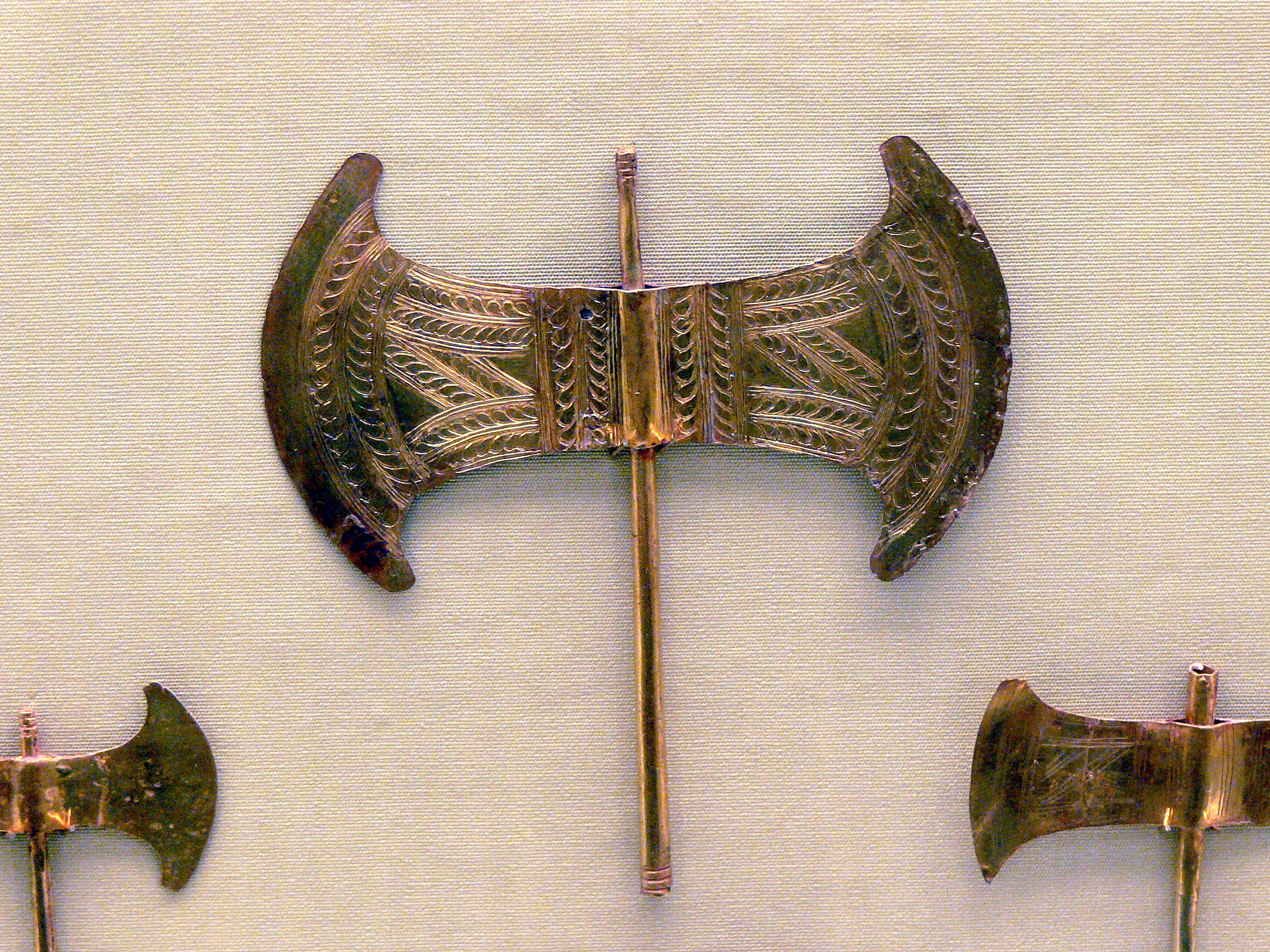 George Huxley regarded the identification of Apollo with the Minoan deity Paiawon, worshipped in Crete, to have originated at Delphi. In the ''Homeric Hymn'', Apollo appeared as a dolphin and carried Cretan priests to Delphi, where they evidently transferred their religious practices. ''Apollo Delphinios'' or ''Delphidios'' was a sea-god especially worshipped in Crete and in the islands. Apollo's sister
George Huxley regarded the identification of Apollo with the Minoan deity Paiawon, worshipped in Crete, to have originated at Delphi. In the ''Homeric Hymn'', Apollo appeared as a dolphin and carried Cretan priests to Delphi, where they evidently transferred their religious practices. ''Apollo Delphinios'' or ''Delphidios'' was a sea-god especially worshipped in Crete and in the islands. Apollo's sister Anatolian origin
 A non-Greek origin of Apollo has long been assumed in scholarship. The name of Apollo's mother
A non-Greek origin of Apollo has long been assumed in scholarship. The name of Apollo's mother Proto-Indo-European
TheOracular cult

 Unusually among the Olympic deities, Apollo had two cult sites that had widespread influence:
Unusually among the Olympic deities, Apollo had two cult sites that had widespread influence: Oracular shrines
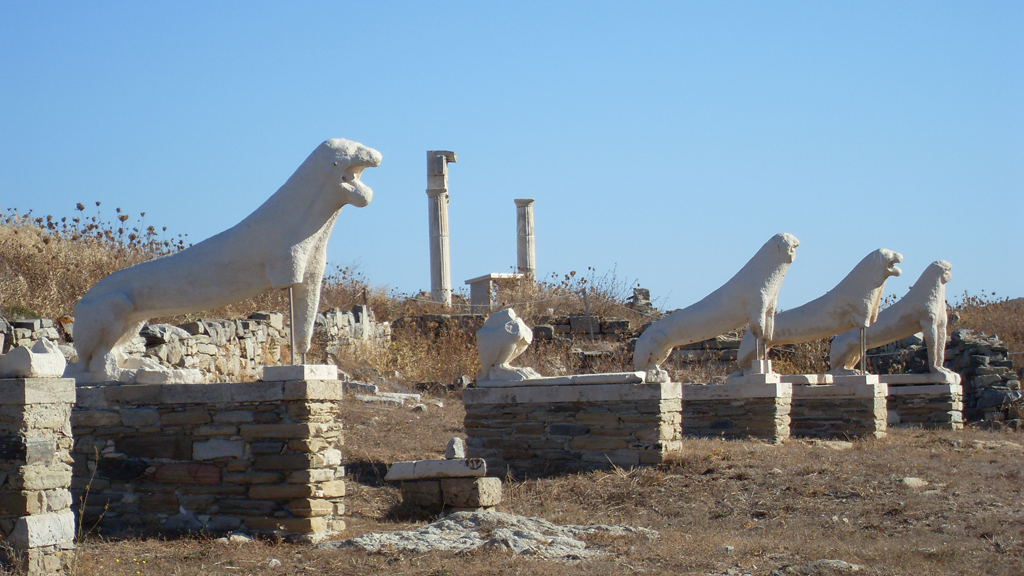 Apollo had a famous
Apollo had a famous Temples of Apollo
Many temples were dedicated to Apollo in Greece and the Greek colonies. They show the spread of the cult of Apollo and the evolution of the Greek architecture, which was mostly based on the rightness of form and on mathematical relations. Some of the earliest temples, especially inGreek temples
* *
* *
*, World Heritage Site. containing a
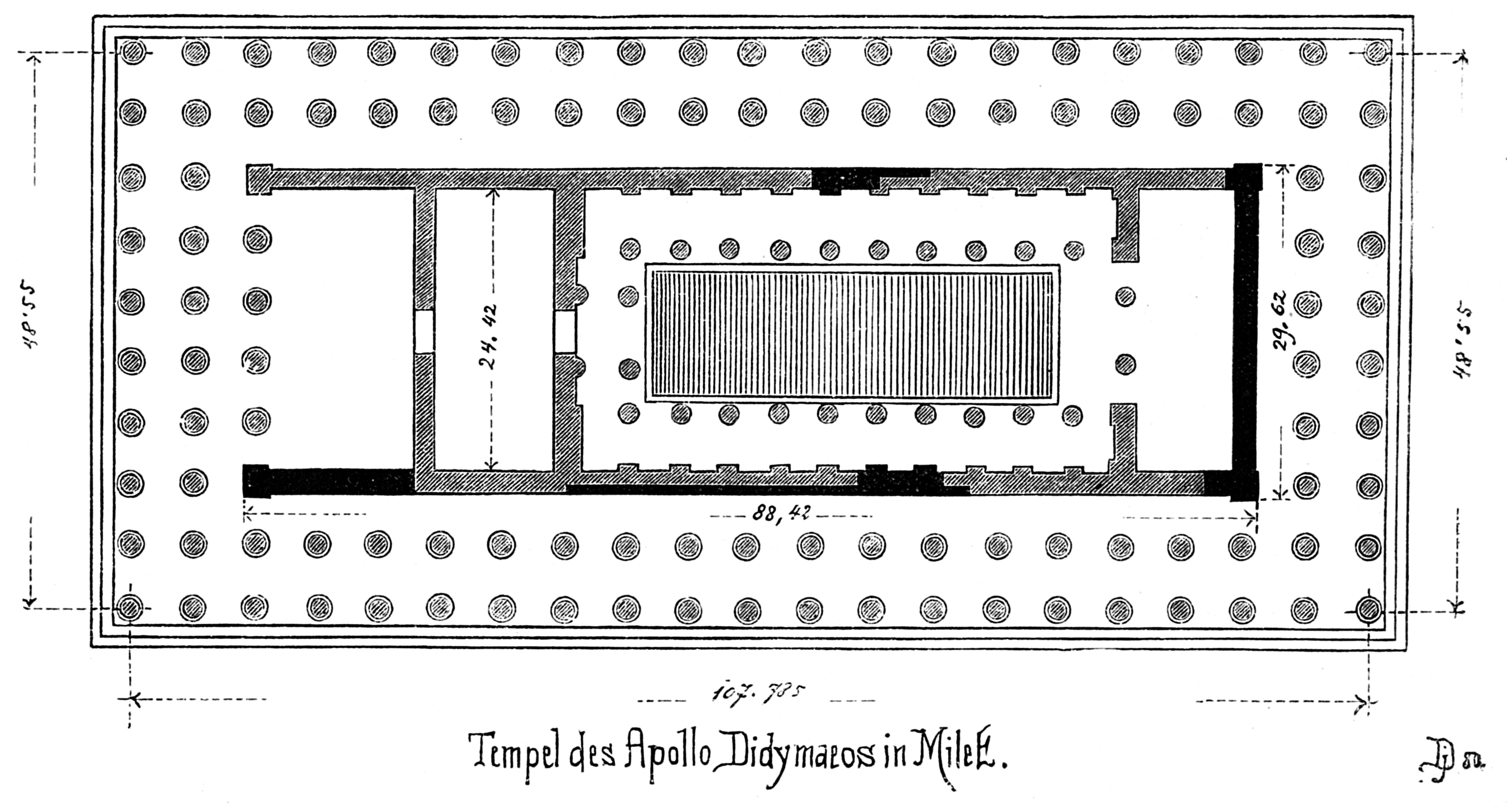 *
*Etruscan and Roman temples
*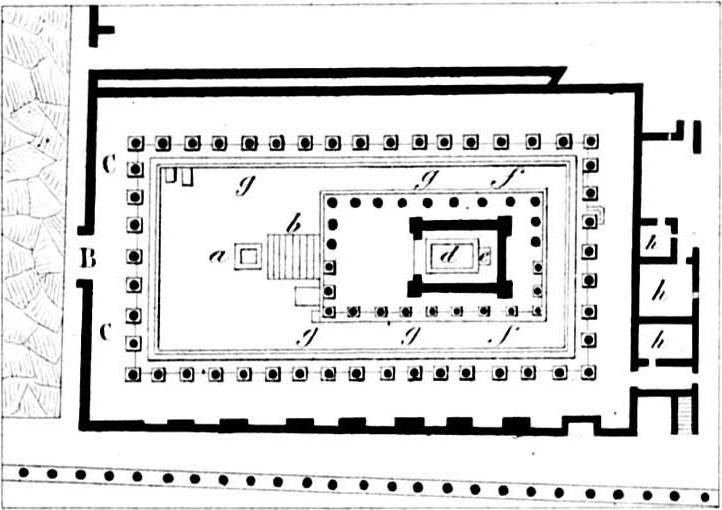 * Pompeii (Italy): The cult of Apollo was widespread in the region of Campania since the 6th century B.C. The temple was built in 120 B.C., but its beginnings lie in the 6th century B.C. It was reconstructed after an earthquake in A.D. 63. It demonstrates a mixing of styles which formed the basis of Roman architecture. The columns in front of the cella formed a Tuscan prostyle porch, and the cella is situated unusually far back. The peripteral colonnade of 48 Ionic columns was placed in such a way that the emphasis was given to the front side.
* Rome: The
* Pompeii (Italy): The cult of Apollo was widespread in the region of Campania since the 6th century B.C. The temple was built in 120 B.C., but its beginnings lie in the 6th century B.C. It was reconstructed after an earthquake in A.D. 63. It demonstrates a mixing of styles which formed the basis of Roman architecture. The columns in front of the cella formed a Tuscan prostyle porch, and the cella is situated unusually far back. The peripteral colonnade of 48 Ionic columns was placed in such a way that the emphasis was given to the front side.
* Rome: The Mythology
Apollo appears often in the myths, plays and hymns. As Zeus' favorite son, Apollo had direct access to the mind of Zeus and was willing to reveal this knowledge to humans. A divinity beyond human comprehension, he appears both as a beneficial and a wrathful god.Birth

 Apollo was the son of Zeus, the king of the gods, and Leto, his previous wife or one of his mistresses. Growing up, Apollo was nursed by the nymphs Korythalia and
Apollo was the son of Zeus, the king of the gods, and Leto, his previous wife or one of his mistresses. Growing up, Apollo was nursed by the nymphs Korythalia and Hyperborea
Childhood and youth
As a child, Apollo is said to have built a foundation and an altar on Delos using the horns of the goats that his sister Artemis hunted. Since he learnt the art of building when young, he later came to be known asPython
Python, a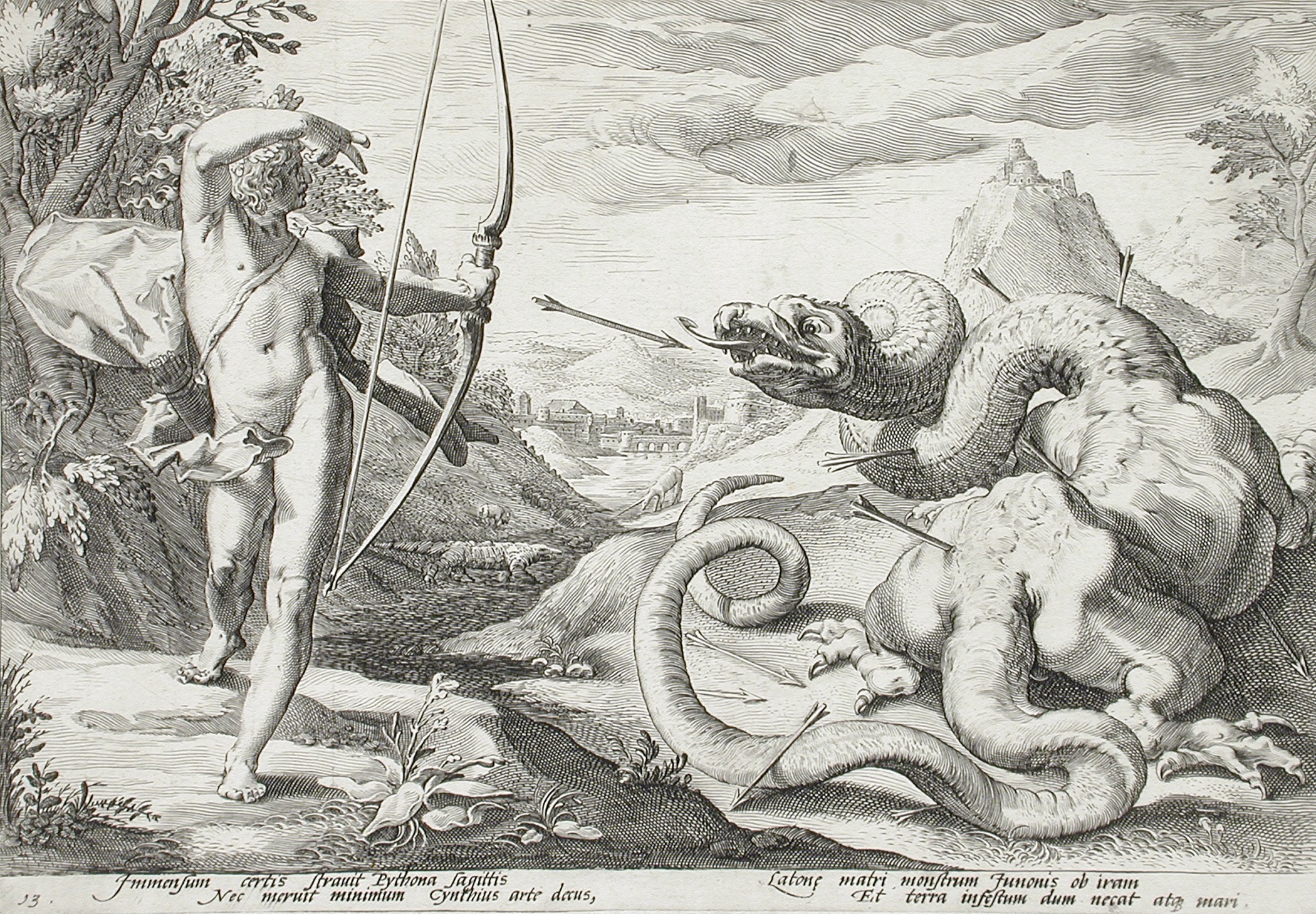 However, Apollo had committed a blood murder and had to be purified. Because Python was a child of
However, Apollo had committed a blood murder and had to be purified. Because Python was a child of Tityos
 Hera once again sent another giant,
Hera once again sent another giant, Admetus
1.9.15
50-51
by taming a lion and a boar to draw Admetus' chariot. He was present during their wedding to give his blessings. When Admetus angered the goddess Artemis by forgetting to give her the due offerings, Apollo came to the rescue and calmed his sister. When Apollo learnt of Admetus' untimely death, he convinced or tricked the
3.10.4
Apollo would have been banished to
Niobe
The fate ofBuilding the walls of Troy
 Once Apollo and
Once Apollo and Trojan War
Apollo sided with the Trojans during the The Trojan hero
The Trojan hero Heracles
After To complete his third task, Heracles had to capture the
To complete his third task, Heracles had to capture the Periphas
Plato's concept of soulmates
A long time ago, there were three kinds of human beings: male, descended from the sun; female, descended from the earth; and androgynous, descended from the moon. Each human being was completely round, with four arms and fours legs, two identical faces on opposite sides of a head with four ears, and all else to match. They were powerful and unruly.Nurturer of the young
Apollo ''Kourotrophos'' is the god who nurtures and protects children and the young, especially boys. He oversees their education and their passage into adulthood. Education is said to have originated from Apollo and the Muses. Many myths have him train his children. It was a custom for boys to cut and dedicate their long hair to Apollo after reaching adulthood. Chiron, the abandoned centaur, was fostered by Apollo, who instructed him in medicine, prophecy, archery and more. Chiron would later become a great teacher himself.God of music
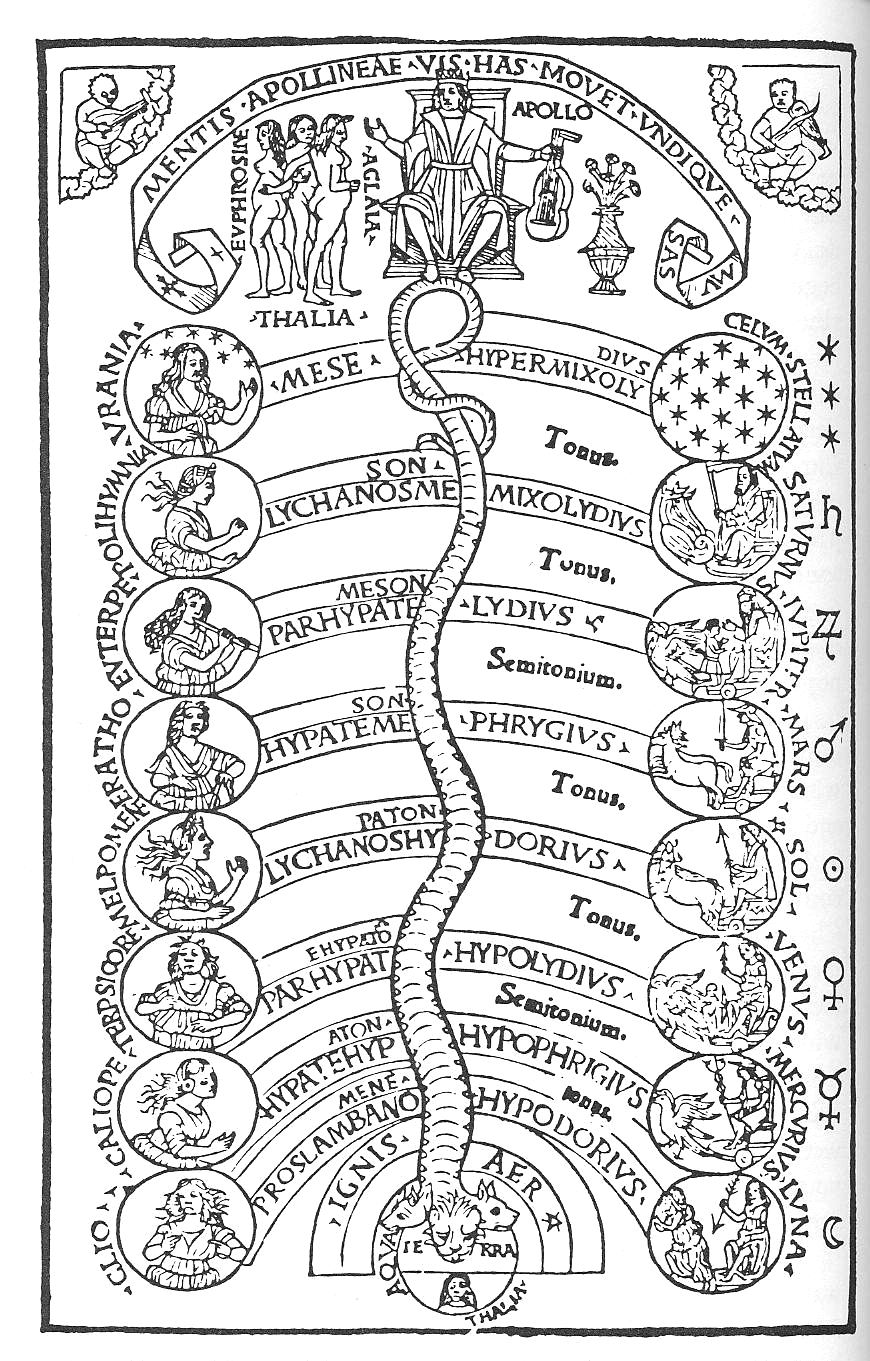 Immediately after his birth, Apollo demanded a lyre and invented the paean, thus becoming the god of music. As the divine singer, he is the patron of poets, singers and musicians. The invention of string music is attributed to him.
Immediately after his birth, Apollo demanded a lyre and invented the paean, thus becoming the god of music. As the divine singer, he is the patron of poets, singers and musicians. The invention of string music is attributed to him. 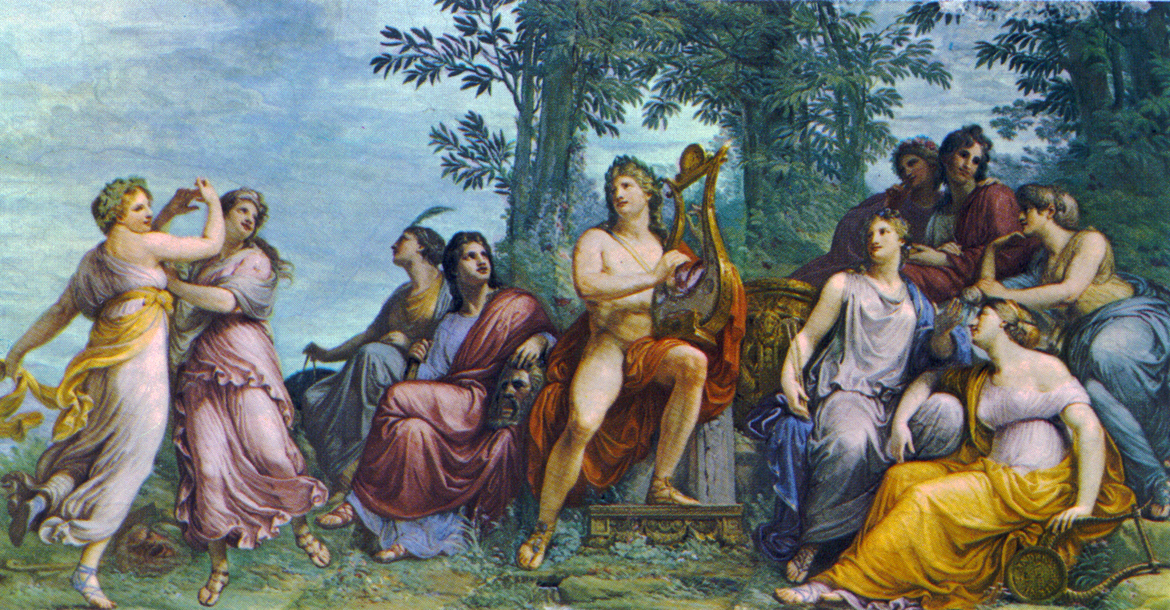 Among the Pythagoreanism, Pythagoreans, the study of mathematics and music were connected to the worship of Apollo, their principal deity. Their belief was that the music purifies the soul, just as medicine purifies the body. They also believed that music was delegated to the same mathematical laws of harmony as the mechanics of the cosmos, evolving into an idea known as the music of the spheres.
Apollo appears as the companion of the Muses, and as Musagetes ("leader of Muses") he leads them in dance. They spend their time on Parnassus, which is one of their sacred places. Apollo is also the lover of the Muses and by them he became the father of famous musicians like Orpheus and Linus of Thrace, Linus.
Apollo is often found delighting the immortal gods with his songs and music on the
Among the Pythagoreanism, Pythagoreans, the study of mathematics and music were connected to the worship of Apollo, their principal deity. Their belief was that the music purifies the soul, just as medicine purifies the body. They also believed that music was delegated to the same mathematical laws of harmony as the mechanics of the cosmos, evolving into an idea known as the music of the spheres.
Apollo appears as the companion of the Muses, and as Musagetes ("leader of Muses") he leads them in dance. They spend their time on Parnassus, which is one of their sacred places. Apollo is also the lover of the Muses and by them he became the father of famous musicians like Orpheus and Linus of Thrace, Linus.
Apollo is often found delighting the immortal gods with his songs and music on the Apollo's lyre
The invention of lyre is attributed either to Hermes or to Apollo himself. Distinctions have been made that Hermes invented lyre made of tortoise shell, whereas the lyre Apollo invented was a regular lyre. Myths tell that the infant Hermes stole a number of Apollo's cows and took them to a cave in the woods near Pylos, covering their tracks. In the cave, he found a tortoise and killed it, then removed the insides. He used one of the cow's intestines and the tortoise shell and made his Upon discovering the theft, Apollo confronted Hermes and asked him to return his cattle. When Hermes acted innocent, Apollo took the matter to Zeus. Zeus, having seen the events, sided with Apollo, and ordered Hermes to return the cattle. Hermes then began to play music on the lyre he had invented. Apollo fell in love with the instrument and offered to exchange the cattle for the lyre. Hence, Apollo then became the master of the lyre.
According to other versions, Apollo had invented the lyre himself, whose strings he tore in repenting of the excess punishment he had given to Marsyas. Hermes' lyre, therefore, would be a reinvention.
Upon discovering the theft, Apollo confronted Hermes and asked him to return his cattle. When Hermes acted innocent, Apollo took the matter to Zeus. Zeus, having seen the events, sided with Apollo, and ordered Hermes to return the cattle. Hermes then began to play music on the lyre he had invented. Apollo fell in love with the instrument and offered to exchange the cattle for the lyre. Hence, Apollo then became the master of the lyre.
According to other versions, Apollo had invented the lyre himself, whose strings he tore in repenting of the excess punishment he had given to Marsyas. Hermes' lyre, therefore, would be a reinvention.
Contest with Pan
 Once Pan (mythology), Pan had the audacity to compare his music with that of Apollo and to challenge the god of music to a contest. The mountain-god Tmolus (son of Ares), Tmolus was chosen to umpire. Pan blew on his pipes, and with his rustic melody gave great satisfaction to himself and his faithful follower, Midas, who happened to be present. Then, Apollo struck the strings of his lyre. It was so beautiful that Tmolus at once awarded the victory to Apollo, and everyone was pleased with the judgement. Only Midas dissented and questioned the justice of the award. Apollo did not want to suffer such a depraved pair of ears any longer, and caused them to become the ears of a donkey.
Once Pan (mythology), Pan had the audacity to compare his music with that of Apollo and to challenge the god of music to a contest. The mountain-god Tmolus (son of Ares), Tmolus was chosen to umpire. Pan blew on his pipes, and with his rustic melody gave great satisfaction to himself and his faithful follower, Midas, who happened to be present. Then, Apollo struck the strings of his lyre. It was so beautiful that Tmolus at once awarded the victory to Apollo, and everyone was pleased with the judgement. Only Midas dissented and questioned the justice of the award. Apollo did not want to suffer such a depraved pair of ears any longer, and caused them to become the ears of a donkey.
Contest with Marsyas
Marsyas was a satyr who was punished by Apollo for his According to one account, after the first round, they both were deemed equal by the Nysiads. But in the next round, Apollo decided to play on his lyre and add his melodious voice to his performance. Marsyas argued against this, saying that Apollo would have an advantage and accused Apollo of cheating. But Apollo replied that since Marsyas played the flute, which needed air blown from the throat, it was similar to singing, and that either they both should get an equal chance to combine their skills or none of them should use their mouths at all. The nymphs decided that Apollo's argument was just. Apollo then played his lyre and sang at the same time, mesmerising the audience. Marsyas could not do this. Apollo was declared the winner and, angered with Marsyas' haughtiness and his accusations, decided to flay the satyr.Diodorus Siculus, Library of History 5. 75. 3
According to one account, after the first round, they both were deemed equal by the Nysiads. But in the next round, Apollo decided to play on his lyre and add his melodious voice to his performance. Marsyas argued against this, saying that Apollo would have an advantage and accused Apollo of cheating. But Apollo replied that since Marsyas played the flute, which needed air blown from the throat, it was similar to singing, and that either they both should get an equal chance to combine their skills or none of them should use their mouths at all. The nymphs decided that Apollo's argument was just. Apollo then played his lyre and sang at the same time, mesmerising the audience. Marsyas could not do this. Apollo was declared the winner and, angered with Marsyas' haughtiness and his accusations, decided to flay the satyr.Diodorus Siculus, Library of History 5. 75. 3
 According to another account, Marsyas played his flute out of tune at one point and accepted his defeat. Out of shame, he assigned to himself the punishment of being skinned for a wine sack. Another variation is that Apollo played his instrument upside down. Marsyas could not do this with his instrument. So the Muses who were the judges declared Apollo the winner. Apollo hung Marsyas from a tree to flay him.
Apollo flaying, flayed the limbs of Marsyas alive in a cave near Celaenae in Phrygia for his
According to another account, Marsyas played his flute out of tune at one point and accepted his defeat. Out of shame, he assigned to himself the punishment of being skinned for a wine sack. Another variation is that Apollo played his instrument upside down. Marsyas could not do this with his instrument. So the Muses who were the judges declared Apollo the winner. Apollo hung Marsyas from a tree to flay him.
Apollo flaying, flayed the limbs of Marsyas alive in a cave near Celaenae in Phrygia for his Contest with Cinyras
Cinyras was a ruler of
Patron of sailors
Apollo functions as the patron and protector of sailors, one of the duties he shares withWars
Titanomachy
OnceTrojan War
Apollo played a pivotal role in the entire Trojan War. He sided with the Trojans, and sent a terrible plague to the Greek camp, which indirectly led to the conflict between
Telegony war
A war broke out between the Brygoi and the Thesprotians, who had the support of Odysseus. The gods Athena and Ares came to the battlefield and took sides. Athena helped the hero Odysseus while Ares fought alongside of the Brygoi. When Odysseus lost, Athena and Ares came into a direct duel. To stop the battling gods and the terror created by their battle, Apollo intervened and stopped the duel between them.Indian war
When Zeus suggested thatTheban war
During the war between the sons of Oedipus, Apollo favoredSlaying of giants
Apollo killed the giants Python and Tityos, who had assaulted his mother Leto.Gigantomachy
During the gigantomachy, Apollo andAloadae
The Aloadae, namely Otis and Ephialtes, were twin giants who decided to wage war upon the gods. They attempted to storm Mt. Olympus by piling up mountains, and threatened to fill the sea with mountains and inundate dry land. They even dared to seek the hand of Hera and Artemis in marriage. Angered by this, Apollo killed them by shooting them with arrows. According to another tale, Apollo killed them by sending a deer between them; as they tried to kill it with their javelins, they accidentally stabbed each other and died.Phorbas
Phorbas was a savage giant king of Phlegyas (Boeotia), Phlegyas who was described as having swine like features. He wished to plunder Delphi for its wealth. He seized the roads to Delphi and started harassing the pilgrims. He captured the old people and children and sent them to his army to hold them for ransom. And he challenged the young and sturdy men to a match of boxing, only to cut their heads off when they would get defeated by him. He hung the chopped off heads to an oak tree. Finally, Apollo came to put an end to this cruelty. He entered a boxing contest with Phorbas and killed him with a single blow.Other stories
 In the first Olympic games, Apollo defeated Ares and became the victor in wrestling. He outran Hermes in the race and won first place.
Apollo divides months into summer and winter. He rides on the back of a swan to the land of the
In the first Olympic games, Apollo defeated Ares and became the victor in wrestling. He outran Hermes in the race and won first place.
Apollo divides months into summer and winter. He rides on the back of a swan to the land of the Molpadia and Parthenos
Molpadia and Parthenos were the sisters of Rhoeo, a former lover of Apollo. One day, they were put in charge of watching their father's ancestral wine jar but they fell asleep while performing this duty. While they were asleep, the wine jar was broken by the swines their family kept. When the sisters woke up and saw what had happened, they threw themselves off a cliff in fear of their father's wrath. Apollo, who was passing by, caught them and carried them to two different cities in Chersonesus, Molpadia to Castabus and Parthenos to Bubastus. He turned them into goddesses and they both received divine honors. Molpadia's name was changed to Hemithea (mythology), Hemithea upon her deification.Prometheus
Prometheus was the titan who was punished by Zeus for stealing fire. He was bound to a rock, where each day an eagle was sent to eat Prometheus' liver, which would then grow back overnight to be eaten again the next day. Seeing his plight, Apollo pleaded Zeus to release the kind Titan, while Artemis and Leto stood behind him with tears in their eyes. Zeus, moved by Apollo's words and the tears of the goddesses, finally sent Heracles to free Prometheus.
The rock of Leukas
Leukatas was believed to be a white colored rock jutting out from the island of Lefkada, Leukas into the sea. It was present in the sanctuary of Apollo Leukates. A leap from this rock was believed to have put an end to the longings of love.Strabo, ''Geographica, Geography''10.2.8
Once, Aphrodite fell deeply in love with Adonis, a young man of great beauty who was later accidentally killed by a boar. Heartbroken, Aphrodite wandered looking for the rock of Leukas. When she reached the sanctuary of Apollo in Argos, she confided in him her love and sorrow. Apollo then brought her to the rock of Leukas and asked her to throw herself from the top of the rock. She did so and was freed from her love. When she sought for the reason behind this, Apollo told her that Zeus, before taking another lover, would sit on this rock to free himself from his love to Hera.Ptolemy Hephaestion, ''New History Book'' 7 Another tale relates that a man named Nireus, who fell in love with the cult statue of Athena, came to the rock and jumped in order relieve himself. After jumping, he fell into the net of a fisherman in which, when he was pulled out, he found a box filled with gold. He fought with the fisherman and took the gold, but Apollo appeared to him in the night in a dream and warned him not to appropriate gold which belonged to others. It was an ancestral custom among the Leukadians to fling a criminal from this rock every year at the sacrifice performed in honor of Apollo for the sake of averting evil. However, a number of men would be stationed all around below rock to catch the criminal and take him out of the borders in order to exile him from the island. This was the same rock from which, according to a legend, Sappho took her suicidal leap.

Female lovers
Love affairs ascribed to Apollo are a late development in Greek mythology. Their vivid anecdotal qualities have made some of them favorites of painters since the Renaissance, the result being that they stand out more prominently in the modern imagination. Daphne was a nymph who scorned Apollo's advances and ran away from him. When Apollo chased her in order to persuade her, she changed herself into a laurel tree. According to other versions, she cried for help during the chase, and
Daphne was a nymph who scorned Apollo's advances and ran away from him. When Apollo chased her in order to persuade her, she changed herself into a laurel tree. According to other versions, she cried for help during the chase, and  Apollo is said to have been the lover of all nine Muses, and not being able to choose one of them, decided to remain unwed. He fathered the Corybantes by the Muse Thalia (Muse), Thalia, Orpheus by Calliope, Linus (Thracian), Linus of Thrace by Calliope or Urania and Hymenaios (Hymen) by one of the Muses.
In the Great Eoiae that is attributed to Hesoid, Scylla is the daughter of Apollo and Hecate.
Cyrene (mythology), Cyrene was a Thessalian princess whom Apollo loved. In her honor, he built the city Cyrene and made her its ruler. She was later granted longevity by Apollo who turned her into a nymph. The couple had two sons, Aristaeus, and Idmon.
Evadne was a nymph daughter of Poseidon and a lover of Apollo. She bore him a son, Iamos. During the time of the childbirth, Apollo sent
Apollo is said to have been the lover of all nine Muses, and not being able to choose one of them, decided to remain unwed. He fathered the Corybantes by the Muse Thalia (Muse), Thalia, Orpheus by Calliope, Linus (Thracian), Linus of Thrace by Calliope or Urania and Hymenaios (Hymen) by one of the Muses.
In the Great Eoiae that is attributed to Hesoid, Scylla is the daughter of Apollo and Hecate.
Cyrene (mythology), Cyrene was a Thessalian princess whom Apollo loved. In her honor, he built the city Cyrene and made her its ruler. She was later granted longevity by Apollo who turned her into a nymph. The couple had two sons, Aristaeus, and Idmon.
Evadne was a nymph daughter of Poseidon and a lover of Apollo. She bore him a son, Iamos. During the time of the childbirth, Apollo sent Male lovers

 Hyacinth (mythology), Hyacinth (or Hyacinthus), a beautiful and athletic Spartan prince, was one of Apollo's favourite lovers. The pair was practicing throwing the Discus throw, discus when a discus thrown by Apollo was blown off course by the jealous Zephyrus and struck Hyacinthus in the head, killing him instantly. Apollo is said to be filled with grief. Out of Hyacinthus' blood, Apollo created a hyacinth (plant), flower named after him as a memorial to his death, and his tears stained the flower petals with the interjection , meaning ''alas''. He was later resurrected and taken to heaven. The festival Hyacinthia was a national celebration of Sparta, which commemorated the death and rebirth of Hyacinthus.
Another male lover was Cyparissus, a descendant of
Hyacinth (mythology), Hyacinth (or Hyacinthus), a beautiful and athletic Spartan prince, was one of Apollo's favourite lovers. The pair was practicing throwing the Discus throw, discus when a discus thrown by Apollo was blown off course by the jealous Zephyrus and struck Hyacinthus in the head, killing him instantly. Apollo is said to be filled with grief. Out of Hyacinthus' blood, Apollo created a hyacinth (plant), flower named after him as a memorial to his death, and his tears stained the flower petals with the interjection , meaning ''alas''. He was later resurrected and taken to heaven. The festival Hyacinthia was a national celebration of Sparta, which commemorated the death and rebirth of Hyacinthus.
Another male lover was Cyparissus, a descendant of 
4.5
During his exile, which lasted either for one year or nine years, Apollo served Admetus as a herdsman. The romantic nature of their relationship was first described by
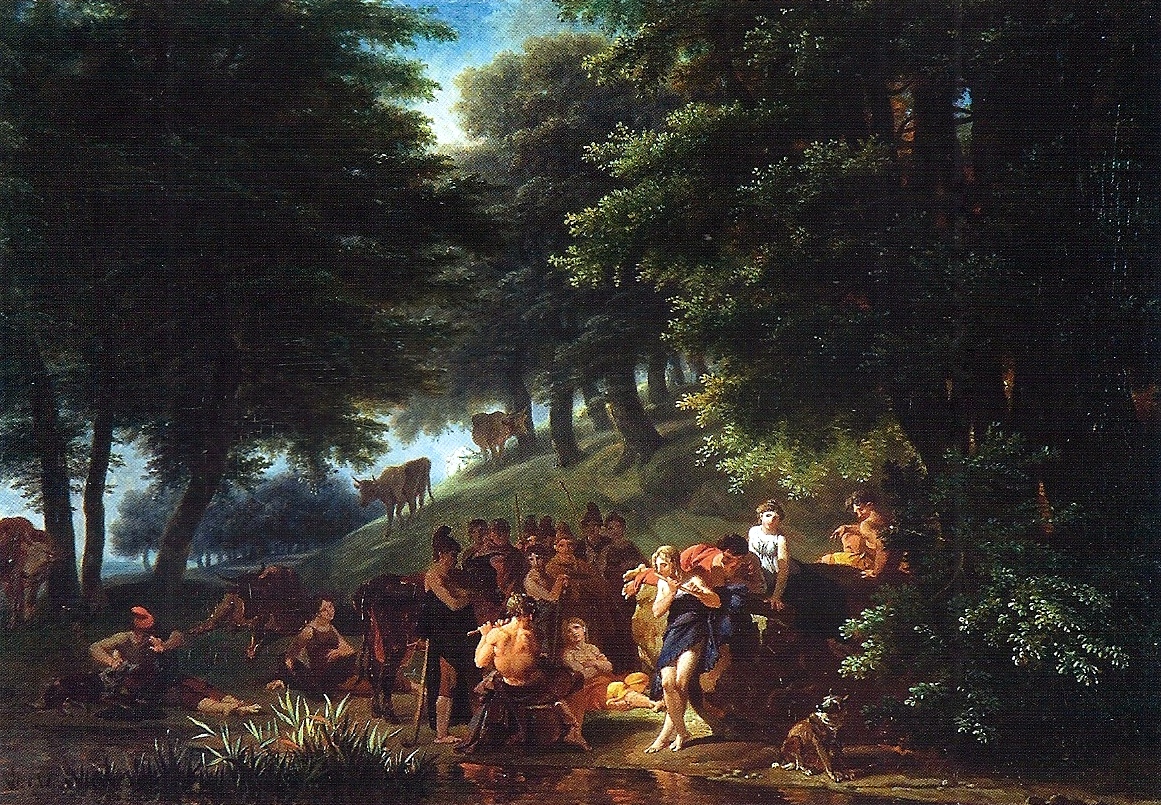 When Admetus wanted to marry princess
When Admetus wanted to marry princess 23
[= Hesiod, ''Megalai Ehoiai'' fr. 16]; Smith 1873
s.v. Hymen
Grimal, s.v. Hymenaeus. *Iapis, to whom Apollo taught the art of healing *Phorbas of Thessaly, Phorbas, the dragon slayer (probably the son of Triopas)Plutarch, ''Numa'
4.5
cf.
2.14
Children
Apollo sired many children, from mortal women and nymphs as well as the goddesses. His children grew up to be physicians, musicians, poets, seers or archers. Many of his sons founded new cities and became kings. They were all usually very beautiful.Failed love attempts
Marpessa (daughter of Evenus), Marpessa was kidnapped by Idas but was loved by Apollo as well.Female counterparts

Artemis
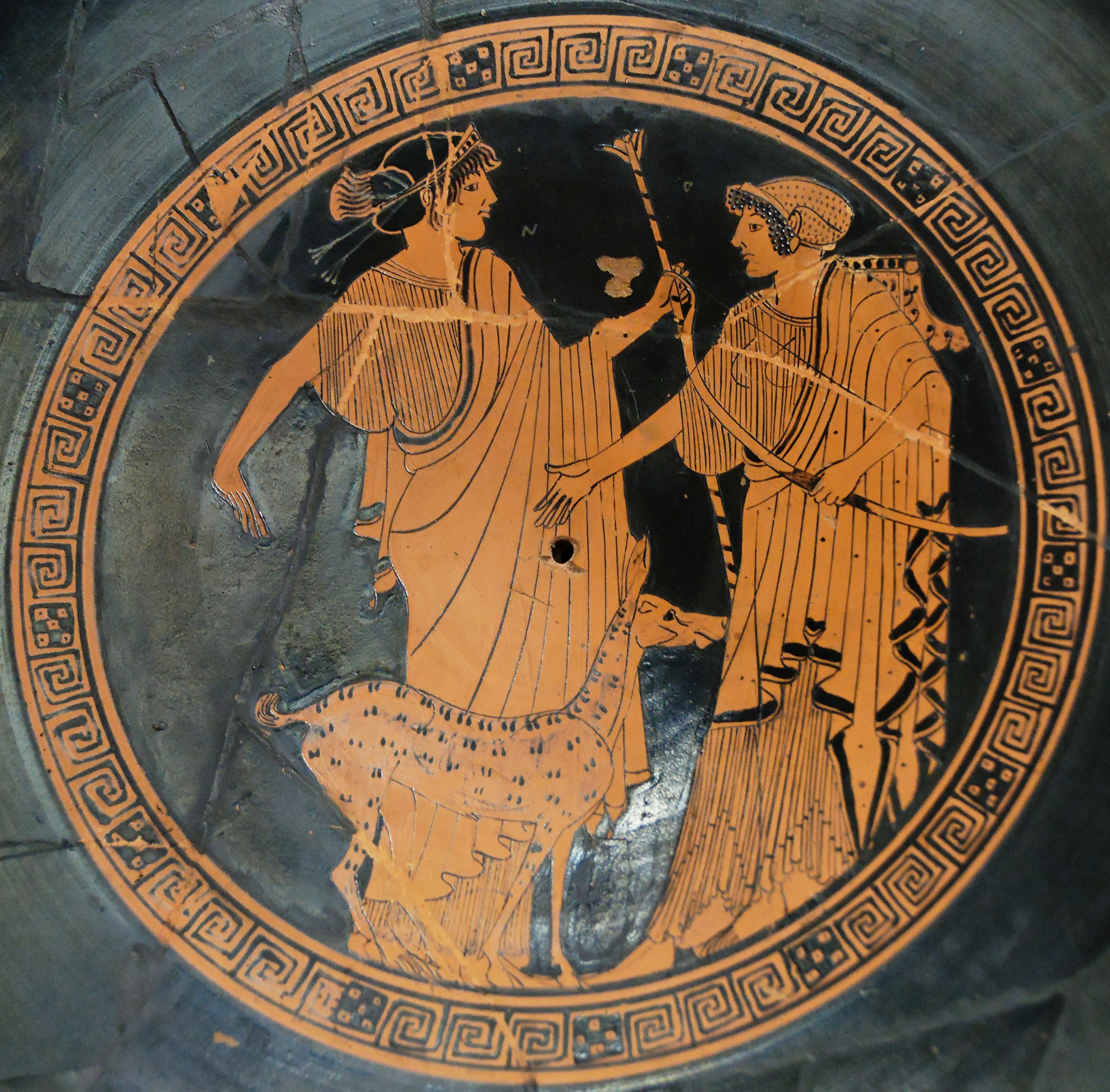 Artemis as the sister of Apollo, is ''thea apollousa'', that is, she as a female divinity represented the same idea that Apollo did as a male divinity. In the pre-Hellenic period, their relationship was described as the one between husband and wife, and there seems to have been a tradition which actually described Artemis as the wife of Apollo. However, this relationship was never sexual but spiritual, which is why they both are seen being unmarried in the Hellenic period.
Artemis, like her brother, is armed with a bow and arrows. She is the cause of sudden deaths of women. She also is the protector of the young, especially girls. Though she has nothing to do with oracles, music or poetry, she sometimes led the female chorus on Olympus while Apollo sang. The laurel (''daphne'') was sacred to both. ''Artemis Daphnaia'' had her temple among the Lacedemonians, at a place called Hypsoi.
''Apollo Daphnephoros'' had a temple in
Artemis as the sister of Apollo, is ''thea apollousa'', that is, she as a female divinity represented the same idea that Apollo did as a male divinity. In the pre-Hellenic period, their relationship was described as the one between husband and wife, and there seems to have been a tradition which actually described Artemis as the wife of Apollo. However, this relationship was never sexual but spiritual, which is why they both are seen being unmarried in the Hellenic period.
Artemis, like her brother, is armed with a bow and arrows. She is the cause of sudden deaths of women. She also is the protector of the young, especially girls. Though she has nothing to do with oracles, music or poetry, she sometimes led the female chorus on Olympus while Apollo sang. The laurel (''daphne'') was sacred to both. ''Artemis Daphnaia'' had her temple among the Lacedemonians, at a place called Hypsoi.
''Apollo Daphnephoros'' had a temple in Hecate
 Hecate, the goddess of witchcraft and magic, is the chthonic counterpart of Apollo. They both are cousins, since their mothers -
Hecate, the goddess of witchcraft and magic, is the chthonic counterpart of Apollo. They both are cousins, since their mothers - Athena
As a deity of knowledge and great power, Apollo was seen being the male counterpart ofApollo in the ''Oresteia''
In Aeschylus' ''Oresteia'' trilogy, Clytemnestra kills her husband, KingRoman Apollo
The Roman worship of Apollo was adopted from the Greeks. As a quintessentially List of Greek mythological figures, Greek god, Apollo had no direct Roman equivalent, although later Roman poets often referred to him as Phoebus. There was a tradition that the Delphic oracle was consulted as early as the period of the Roman Kingdom, kings of Rome during the reign of Tarquinius Superbus. On the occasion of a pestilence in the 430s BCE, Apollo's Temple of Apollo Sosianus, first temple at Rome was established in the Flaminian fields, replacing an older cult site there known as the "Apollinare". During the Second Punic War in 212 BCE, the ''Ludi Apollinares'' ("Apollonian Games") were instituted in his honor, on the instructions of a prophecy attributed to one Marcius. In the time ofFestivals
The chief Apollonian festival was the Pythian Games held every four years at Delphi and was one of the four great Panhellenic Games. Also of major importance was the Delia (festival), Delia held every four years on Delos. Athenian annual festivals included the Boedromia, Metageitnia, Pyanepsia, andAttributes and symbols
Apollo's most common attributes were the bow and arrow. Other attributes of his included the kithara (an advanced version of the common The palm tree was also sacred to Apollo because he had been born under one in
The palm tree was also sacred to Apollo because he had been born under one in /ref> In many myths Apollo is transformed into a hawk. In addition, Claudius Aelianus wrote that in Egyptians, Ancient Egypt people believed that hawks were sacred to the god and that according to the ministers of Apollo in Egypt there were certain men called "hawk-keepers" (ἱερακοβοσκοί) who fed and tended the hawks belonging to the god. Eusebius wrote that the second appearance of the moon is held sacred in the city of Apollo in Egypt and that the city's symbol is a man with a hawklike face (Horus). Claudius Aelianus wrote that Egyptians called Apollo Horus in their own language.Aelian, ''Characteristics of Animals'', 10.14
/ref>
 As god of colonization, Apollo gave oracular guidance on colonies, especially during the height of colonization, 750–550 BCE. According to Greek tradition, he helped Crete, Cretan or Arcadia (ancient region), Arcadian colonists found the city of
As god of colonization, Apollo gave oracular guidance on colonies, especially during the height of colonization, 750–550 BCE. According to Greek tradition, he helped Crete, Cretan or Arcadia (ancient region), Arcadian colonists found the city of Apollo in the arts
Apollo is a common theme in Greek and Roman art and also in the art of the Renaissance. The earliest Greek word for a statue is "delight" (, ''agalma''), and the sculptors tried to create forms which would inspire such guiding vision. Greek art puts into Apollo the highest degree of power and beauty that can be imagined. The sculptors derived this from observations on human beings, but they also embodied in concrete form, issues beyond the reach of ordinary thought. The naked bodies of the statues are associated with the cult of the body that was essentially a religious activity. The muscular frames and limbs combined with slim waists indicate the Greek desire for health, and the physical capacity which was necessary in the hard Greek environment. The statues of Apollo embody beauty, balance and inspire awe before the beauty of the world.Archaic sculpture
Numerous free-standing statues of male youths fromClassical sculpture

 The famous Apollo of Mantua and its variants are early forms of the Apollo Citharoedus statue type, in which the god holds the cithara, a sophisticated seven-stringed variant of the lyre, in his left arm. While none of the Greek originals have survived, several Roman copies from approximately the late 1st or early 2nd century exist.
Other notable forms are the Apollo Citharoedus and the Apollo Barberini.
The famous Apollo of Mantua and its variants are early forms of the Apollo Citharoedus statue type, in which the god holds the cithara, a sophisticated seven-stringed variant of the lyre, in his left arm. While none of the Greek originals have survived, several Roman copies from approximately the late 1st or early 2nd century exist.
Other notable forms are the Apollo Citharoedus and the Apollo Barberini.
Hellenistic Greece-Rome
Apollo as a handsome beardless young man, is often depicted with a cithara (as Apollo Citharoedus) or bow in his hand, or reclining on a tree (the Apollo Lykeios and Apollo Sauroctonos types). The Apollo Belvedere is a marble sculpture that was rediscovered in the late 15th century; for centuries it epitomized the ideals of Classical Antiquity for Europeans, from the Renaissance through the 19th century. The marble is a Hellenistic Greece, Hellenistic or Roman copy of a bronze original by the Greek sculptor Leochares, made between 350 and 325 BCE. The life-size so-called "Adonis" found in 1780 on the site of a ''Roman villa, villa suburbana'' near the Via Labicana in the Roman suburb of Centocelle is identified as an Apollo by modern scholars. In the late 2nd century CE floor mosaic from El Djem, Roman ''Thysdrus'', he is identifiable as Helios, Apollo Helios by his effulgent Halo (religious iconography), halo, though now even a god's divine nudity, nakedness is concealed by his cloak, a mark of increasing conventions of modesty in the later Roman Empire, Empire. Another haloed Apollo in mosaic, from Hadrumentum, is in the museum at Sousse. The conventions of this representation, head tilted, lips slightly parted, large-eyed, curling Hairstyle, hair cut in locks grazing the neck, were developed in the 3rd century BCE to depict Alexander the Great. Some time after this mosaic was executed, the earliest depictions of Christ would also be beardless and haloed.Modern reception
Apollo often appears in Modernity, modern and Greek mythology in popular culture, popular culture due to his status as the god of music, dance and poetry.Postclassical art and literature
Dance and music
Apollo has featured in dance and music in modern culture. Percy Bysshe Shelley composed a "Hymn of Apollo" (1820), and the god's instruction of the Muses formed the subject of Igor Stravinsky's ''Apollon musagète'' (1927–1928). In 1978, the Canadian band Rush (band), Rush released Hemispheres (Rush album), an album with songs Cygnus X-1 Book II, "Apollo: Bringer of Wisdom"/"Dionysus: Bringer of Love".Books
Apollo been portrayed in modern literature, such as when Charles Handy, in ''Gods of Management'' (1978) uses Greek gods as a metaphor to portray various types of organizational culture. Apollo represents a 'role' culture where order, reason, and bureaucracy prevail. In 2016, author Rick Riordan published the first book in the Trials of Apollo series, publishing four other books in the series in 2017, 2018, 2019 and 2020.
Film
Apollo has been depicted in modern films—for instance, by Keith David in the 1997 animated feature film ''Hercules (1997 film), Hercules,'' by Luke Evans in the 2010 action film Clash of the Titans (2010 film), ''Clash of the Titans'', and by Dimitri Lekkos in the 2010 film ''Percy Jackson & the Olympians: The Lightning Thief''.Video games
Apollo has appeared in many modern video games. Apollo appears as a minor character in Santa Monica Studio's 2010 Action-adventure game, action-adventure game ''God of War III'' with his bow being used by Pirithous, Peirithous. He also appears in the 2014 Hi-Rez Studios Multiplayer online battle arena, Multiplayer Online Battle Arena game ''Smite (video game), Smite'' as a playable character.Psychology and philosophy
In philosophical discussion of the arts, a distinction is sometimes made between the Apollonian and Dionysian impulses, where the former is concerned with imposing intellectual order and the latter with chaotic creativity. Friedrich Nietzsche argued that a fusion of the two was most desirable. Psychologist Carl Jung's Apollo archetype represents what he saw as the disposition in people to over-intellectualise and maintain emotional distance.Shinoda-Bolen, J., ''Gods in Everyman: A New Psychology of Men's Lives and Loves'' p.130-160 (1989)Spaceflight
In spaceflight, the 1960s and 1970s NASA program for orbiting and landing astronauts on the Moon was named after Apollo program, Apollo, by NASA manager Abe Silverstein:Genealogy
See also
*Darrhon *Dryad *Epirus *Family tree of the Greek gods *Phoebus (disambiguation) *Sibylline oracles *Tegyra *Temple of Apollo (disambiguation)Notes
References
Sources
Primary sources
* Claudius Aelianus, Aelian, ''On Animals'', Volume II: Books 6–11. Translated by A. F. Scholfield. Loeb Classical Library 447. Cambridge, MA: Harvard University Press, 1958. * Aeschylus, ''Oresteia, The Eumenides'' in ''Aeschylus, with an English translation by Herbert Weir Smyth, Ph. D. in two volumes'', Vol 2, Cambridge, Massachusetts, Harvard University Press, 1926Online version at the Perseus Digital Library
* Antoninus Liberalis, ''The Metamorphoses of Antoninus Liberalis'' translated by Francis Celoria (Routledge 1992)
Online version at the Topos Text Project.
*
Online version at the Perseus Digital Library
* Apollonius of Rhodes, ''Apollonius Rhodius: the Argonautica'', translated by Robert Cooper Seaton, W. Heinemann, 1912
Internet Archive
*
Online version at Harvard University Press
* Cicero, Cicero, Marcus Tullius, ''De Natura Deorum'' in ''Cicero in Twenty-eight Volumes, XIX De Natura Deorum; Academica'', with an English translation by H. Rackham, Cambridge, Massachusetts: Harvard University Press; London: William Heinemann, Ltd, 1967
Internet Archive
* Diodorus Siculus, ''Library of History, Volume III: Books 4.59-8'', translated by Charles Henry Oldfather, C. H. Oldfather, Loeb Classical Library No. 340. Cambridge, Massachusetts, Harvard University Press, 1939.
Online version at Harvard University Press
* Herodotus, ''Herodotus, with an English translation by A. D. Godley.'' Cambridge. Harvard University Press. 1920
Online version available at The Perseus Digital Library
* Hesiod, ''Theogony'', in ''The Homeric Hymns and Homerica with an English Translation by Hugh G. Evelyn-White'', Cambridge, MA., Harvard University Press; London, William Heinemann Ltd. 1914
Online version at the Perseus Digital Library
* ''Homeric Hymn 3 to Apollo'' in ''The Homeric Hymns and Homerica with an English Translation by Hugh G. Evelyn-White'', Cambridge, MA., Harvard University Press; London, William Heinemann Ltd. 1914
Online version at the Perseus Digital Library
* ''Homeric Hymns, Homeric Hymn'' 4 ''to Hermes'', in ''The Homeric Hymns and Homerica with an English Translation by Hugh G. Evelyn-White'', Cambridge, Massachusetts, Harvard University Press; London, William Heinemann Ltd. 1914
Online version at the Perseus Digital Library
*
Online version at the Perseus Digital Library
*
Online version at the Perseus Digital Library
* Gaius Julius Hyginus, Hyginus, Gaius Julius, ''De Astronomica'', in ''The Myths of Hyginus'', edited and translated by Mary A. Grant, Lawrence: University of Kansas Press, 1960
Online version at ToposText
* Gaius Julius Hyginus, Hyginus, Gaius Julius, ''
Online version at ToposText
* Livy, ''The History of Rome, Books I and II With An English Translation''. Cambridge. Cambridge, Mass., Harvard University Press; London, William Heinemann, Ltd. 1919. * Nonnus, ''Dionysiaca''; translated by W. H. D. Rouse, Rouse, W H D, I Books I-XV. Loeb Classical Library No. 344, Cambridge, Massachusetts, Harvard University Press; London, William Heinemann Ltd. 1940
Internet Archive
* Nonnus, ''Dionysiaca''; translated by W. H. D. Rouse, Rouse, W H D, II Books XVI-XXXV. Loeb Classical Library No. 345, Cambridge, Massachusetts, Harvard University Press; London, William Heinemann Ltd. 1940
Internet Archive
* Statius, ''Thebaid (Latin poem), ''Thebaid''''. Translated by Mozley, J H. Loeb Classical Library Volumes. Cambridge, Massachusetts, Harvard University Press; London, William Heinemann Ltd. 1928. * Strabo, ''Geographica, The Geography of Strabo.'' Edition by H.L. Jones. Cambridge, Mass.: Harvard University Press; London: William Heinemann, Ltd. 1924
Online version at the Perseus Digital Library.
* Sophocles, ''Oedipus Rex'' * Palaephatus, ''On Unbelievable Tales'' 46. Hyacinthus (330 BCE) *
Online version at the Perseus Digital Library
10. 162–219 (1–8 CE) *
Online version at the Perseus Digital Library
* Philostratus the Elder, ''Imagines (work by Philostratus), Imagines'', in ''Philostratus the Elder, Imagines. Philostratus the Younger, Imagines. Callistratus, Descriptions.'' Translated by Arthur Fairbanks. Loeb Classical Library No. 256. Cambridge, Massachusetts: Harvard University Press, 1931.
Online version at Harvard University Press
Internet Archive 1926 edition
i.24 Hyacinthus (170–245 CE) * Philostratus the Younger, ''Imagines (work by Philostratus), Imagines'', in ''Philostratus the Elder, Imagines. Philostratus the Younger, Imagines. Callistratus, Descriptions.'' Translated by Arthur Fairbanks. Loeb Classical Library No. 256. Cambridge, Massachusetts: Harvard University Press, 1931.
Online version at Harvard University Press
14. Hyacinthus (170–245 CE) *
Online version at the Perseus Digital Library
* Plutarch. ''Lives, Volume I: Theseus and Romulus. Lycurgus and Numa. Solon and Publicola.'' Translated by Bernadotte Perrin. Loeb Classical Library No. 46. Cambridge, Massachusetts: Harvard University Press, 1914.
Online version at Harvard University Press
* Pseudo-Plutarch, ''De fluviis'', in ''Plutarch's morals, Volume V'', edited and translated by William Watson Goodwin, Boston: Little, Brown & Co., 1874
Online version at the Perseus Digital Library
* Lucian, ''Dialogues of the Dead. Dialogues of the Sea-Gods. Dialogues of the Gods. Dialogues of the Courtesans'', translated by M. D. MacLeod, Loeb Classical Library No. 431, Cambridge, Massachusetts, Harvard University Press, 1961.
Online version at Harvard University Press
* First Vatican Mythographer, 197. Thamyris et Musae * John Tzetzes, Tzetzes, John, ''Chiliades'', editor Gottlieb Kiessling, F.C.G. Vogel, 1826
Google Books
(English translation: Book I by Ana Untila; Books II–IV, by Gary Berkowitz; Books V–VI by Konstantino Ramiotis; Books VII–VIII by Vasiliki Dogani; Books IX–X by Jonathan Alexander; Books XII–XIII by Nikolaos Giallousis
Internet Archive
. * Gaius Valerius Flaccus (poet), Valerius Flaccus, ''Argonautica'', translated by J. H. Mozley, Loeb Classical Library No. 286. Cambridge, Massachusetts, Harvard University Press; London, William Heinemann Ltd. 1928.
Online version at Harvard University Press
* Virgil, Vergil, ''Aeneid.'' Theodore C. Williams. trans. Boston. Houghton Mifflin Co. 1910
Online version at the Perseus Digital Library.
Secondary sources
* Apostolos Athanassakis, Athanassakis, Apostolos N., and Benjamin M. Wolkow, ''The Orphic Hymns'', Johns Hopkins University Press; owlerirst Printing edition (May 29, 2013).Google Books
* M. Bieber, 1964. ''Alexander the Great in Greek and Roman Art''. Chicago. * Hugh Bowden, 2005. ''Classical Athens and the Delphic Oracle: Divination and Democracy''. Cambridge University Press. *
Greek Religion
' (Harvard University Press) III.2.5 ''passim'' * * Joseph Fontenrose, Fontenrose, Joseph Eddy, ''Python: A Study of Delphic Myth and Its Origins'', University of California Press, 1959. . * Gantz, Timothy, ''Early Greek Myth: A Guide to Literary and Artistic Sources'', Johns Hopkins University Press, 1996, Two volumes: (Vol. 1), (Vol. 2). * * Miranda J. Green, 1997. ''Dictionary of Celtic Myth and Legend'', Thames and Hudson. * Grimal, Pierre, ''The Dictionary of Classical Mythology'', Wiley-Blackwell, 1996. . * Hard, Robin, ''The Routledge Handbook of Greek Mythology: Based on H.J. Rose's "Handbook of Greek Mythology"'', Psychology Press, 2004,
Google Books
* Karl Kerenyi, 1953. ''Apollon: Studien über Antiken Religion und Humanität'' revised edition. * Károly Kerényi, Kerényi, Karl 1951, ''The Gods of the Greeks'', Thames and Hudson, London. * Mertens, Dieter; Schutzenberger, Margareta. ''Città e monumenti dei Greci d'Occidente: dalla colonizzazione alla crisi di fine V secolo a.C.''. Roma L'Erma di Bretschneider, 2006. . * Martin Nilsson, 1955. ''Die Geschichte der Griechische Religion'', vol. I. C.H. Beck. * Parada, Carlos, ''Genealogical Guide to Greek Mythology'', Jonsered, Paul Åströms Förlag, 1993. . * Pauly–Wissowa, ''Realencyclopädie der klassischen Altertumswissenschaft'': II, "Apollon". The best repertory of cult sites (Burkert). * Harry Thurston Peck, Peck, Harry Thurston, ''Harpers Dictionary of Classical Antiquities'', New York. Harper and Brothers. 1898
Online version at the Perseus Digital Library
* Pfeiff, K.A., 1943. ''Apollon: Wandlung seines Bildes in der griechischen Kunst''. Traces the changing iconography of Apollo. * D.S.Robertson (1945) ''A handbook of Greek and Roman Architecture'' Cambridge University Press * William Smith (lexicographer), Smith, William; ''Dictionary of Greek and Roman Biography and Mythology'', London (1873)
"Apollo"
* * William Smith (lexicographer), Smith, William, ''A Dictionary of Greek and Roman Antiquities''. William Smith, LLD. William Wayte. G. E. Marindin. Albemarle Street, London. John Murray. 1890
Online version at the Perseus Digital Library
* Spivey Nigel (1997) ''Greek art'' Phaedon Press Ltd.
External links
at the Greek Mythology Link, by Carlos Parada
The Warburg Institute Iconographic Database: ca 1650 images of Apollo
{{Authority control Apollo, Greek gods Roman gods Beauty gods Health gods Knowledge gods Light gods Maintenance deities Music and singing gods Oracular gods Solar gods Plague gods Dragonslayers Mythological Greek archers Mythological rapists Homosexuality and bisexuality deities Divine twins Deities in the Iliad Metamorphoses characters Musicians in Greek mythology Characters in Greek mythology LGBT themes in Greek mythology Children of Zeus Characters in the Odyssey Characters in the Argonautica Characters in Roman mythology Childhood gods Mythological Greek physicians Arts gods Dii Consentes Medicine deities Mercurian deities Twelve Olympians Dance gods Kourotrophoi Shapeshifters in Greek mythology Prophecy